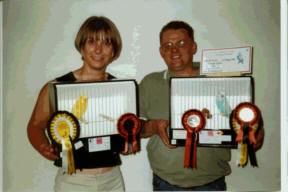
Name: Paul and Nicki Stannard
Status: Intermediate Breeders
Town: Hereford

Introduction
We are both interested in livestock, so being in partnership with the birds came natural, both understanding the qualities of good Budgerigars. This will be our last year as Intermediates, next year in 2002 we will be progressing to Champion status. We obtained our first Spangle from Graham Cunningham in 1994. This bird was paired to our number one stud cock, these birds produced many youngsters in Spangle and normal and are the two foundation birds of our stud today.
Birds Kept
We keep approximately 250 to 300 birds in all the main stream varieties and colours including Yellowfaces and Spangles. At the moment we are having a dabble with Yellows but this will take a few seasons to get the line started. We have had good results in the first year, but we only bred birds that are split for ‘Dilute’. We are hoping that these ‘splits’ will improve the size of the Yellows and will mix them into all of our birds, and hopefully one day we will have great pleasure when a good Yellow pops out of the nest box.
We try to keep as many good birds as possible. The numbers do not bother us, its the quality that is important. It is always easy to sell good birds but breeding one is another story. At the moment we have approximately 40 Spangles. The attraction of Spangles to us is that they can come in so many colours and varieties. We like all the colours, especially the Spangle Yellowface.
Spangle Pairings
Our Spangle pairings vary from Spangle x Normal; Spangle x Yellowface; Spangle x Cinnamon; Spangle x Spangle; and Spangle x Double Factor Spangle. We use Cinnamon in our Spangle pairings as they have been very successful for us on the show bench. We do try to avoid pairing Opalines into the Spangles, but we will pair a Spangle Opaline to a Spangle.
We would probably use all varieties in the Spangle Variety, as we look at the quality of Budgerigar first, I know specialist breeders would probably disagree, we are all for improving the variety but the Budgie comes first.
We use Double Factors in our breeding team, we don’t know if they improve the Spangle, but when pairing to other Spangles they produce Spangles in numbers that we can use for future breeding.
Why we keep Spangles
The Spangle has many good points, and for us we consider the variety is a very attractive Budgerigar, they produce all colours and varieties. Over the years many Spangles have taken top awards and the classes are always strong, whereas many other colours and varieties are on the decline. Also, Spangles are in great demand, and are easy to dispose of.
Some of the bad points we have noticed, of which we have only seen a few, these are mainly Spangle Opalines which are not so attractive in spangled markings as the Spangle Normal.
Spangle Spots
The continuing story of spots keeps on cropping up – very few Spangles have the desired bullseye spots, some have very feint outlines, some carry normal spots, and in some Spangles they are just non existent. We think the problem with spots could be connected to the feather on different lines of birds. Where the spot just shows visible lines on the outside of the spots, we think may be attributed to the width of feather, this makes the spot stretch so the visible bullseye disappears. Tighter or finer feathered birds seem to show good examples of the bullseye spot, but we have also had buff feathered birds carry the desired bullseye spot.
Separate Classes for Double Factors
We find it very unfair to exhibit Double Factor Spangles in the present Spangle classes. We all strive for perfect wing markings and bullseye spots. We feel that the Double Factor has nothing to offer in variety colour or content. The only thing it has to offer is a good Budgie, which we must not knock, but I must say, we do like the Double Factor in White or Yellow, especially if there is a good Budgie to look at.
Variety Content
We aim to try to breed Spangles with good variety content . Sometimes we have found that an individual bird may be dominant in producing good spangled wing markings, but the spots have been poor. If anyone knows how to produce the bird to produces good spots, please let us know.
We have had great success with showing Spangles over the years and seem to have struck it lucky with this variety, so we have kept on producing Spangles and hopefully that winner pops out. If we had struck it lucky with another variety, say Dominant Pieds, we would have continued with that variety.
Spangle Review
Issue No. 28 - Winter 2001